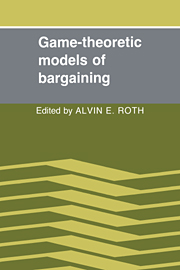Book contents
- Frontmatter
- Contents
- List of contributors
- Preface
- Chapter 1 Editor's introduction and overview
- Chapter 2 Disagreement in bargaining: Models with incomplete information
- Chapter 3 Reputations in games and markets
- Chapter 4 An approach to some noncooperative game situations with special attention to bargaining
- Chapter 5 Infinite-horizon models of bargaining with one-sided incomplete information
- Chapter 6 Choice of conjectures in a bargaining game with incomplete information
- Chapter 7 Analysis of two bargaining problems with incomplete information
- Chapter 8 Sequential bargaining mechanisms
- Chapter 9 The role of risk aversion in a simple bargaining model
- Chapter 10 Risk sensitivity and related properties for bargaining solutions
- Chapter 11 Axiomatic theory of bargaining with a variable population: A survey of recent results
- Chapter 12 Toward a focal-point theory of bargaining
- Chapter 13 Bargaining and coalitions
- Chapter 14 Axiomatic approaches to coalitional bargaining
- Chapter 15 A comment on the Coase theorem
- Chapter 16 Disclosure of evidence and resolution of disputes: Who should bear the burden of proof?
- Chapter 17 The role of arbitration and the theory of incentives
Chapter 14 - Axiomatic approaches to coalitional bargaining
Published online by Cambridge University Press: 23 September 2009
- Frontmatter
- Contents
- List of contributors
- Preface
- Chapter 1 Editor's introduction and overview
- Chapter 2 Disagreement in bargaining: Models with incomplete information
- Chapter 3 Reputations in games and markets
- Chapter 4 An approach to some noncooperative game situations with special attention to bargaining
- Chapter 5 Infinite-horizon models of bargaining with one-sided incomplete information
- Chapter 6 Choice of conjectures in a bargaining game with incomplete information
- Chapter 7 Analysis of two bargaining problems with incomplete information
- Chapter 8 Sequential bargaining mechanisms
- Chapter 9 The role of risk aversion in a simple bargaining model
- Chapter 10 Risk sensitivity and related properties for bargaining solutions
- Chapter 11 Axiomatic theory of bargaining with a variable population: A survey of recent results
- Chapter 12 Toward a focal-point theory of bargaining
- Chapter 13 Bargaining and coalitions
- Chapter 14 Axiomatic approaches to coalitional bargaining
- Chapter 15 A comment on the Coase theorem
- Chapter 16 Disclosure of evidence and resolution of disputes: Who should bear the burden of proof?
- Chapter 17 The role of arbitration and the theory of incentives
Summary
Introduction
The simplest bargaining situation is that of two persons who have to agree on the choice of an outcome from a given set of feasible outcomes; in case no agreement is reached, a specified disagreement outcome results. This two-person pure bargaining problem has been extensively analyzed, starting with Nash (1950).
When there are more than two participants, the n-person straightforward generalization considers either unanimous agreement or complete disagreement (see Roth (1979)). However, intermediate subsets of the players (i.e., more than one but not all) may also play an essential role in the bargaining. One is thus led to an n-person coalitional bargaining problem, where a set of feasible outcomes is specified for each coalition (i.e., subset of the players). This type of problem is known as a game in coalitional form without side payments (or, with nontransferable utility).
It frequently arises in the analysis of various economic and other models; for references, see Aumann (1967, 1983a).
Solutions to such problems have been proposed by Harsanyi (1959, 1963, 1977), Shapley (1969), Owen (1972), and others. All of these were constructed to coincide with the Nash solution in the two-person case. Unlike the Nash solution, however, they were not defined (and determined) by a set of axioms.
Recently, Aumann (1983b) has provided an axiomatization for the Shapley solution. Following this work, further axiomatizations were obtained: for the Harsanyi solution by Hart (1983), and for a new class of monotonic solutions by Kalai and Samet (1983).
- Type
- Chapter
- Information
- Game-Theoretic Models of Bargaining , pp. 305 - 320Publisher: Cambridge University PressPrint publication year: 1985
- 1
- Cited by



